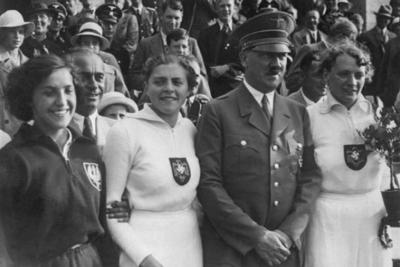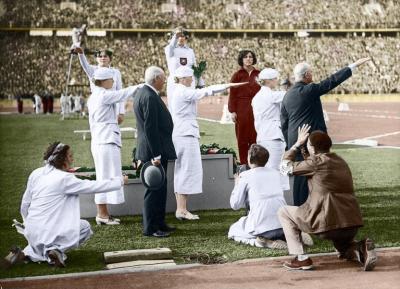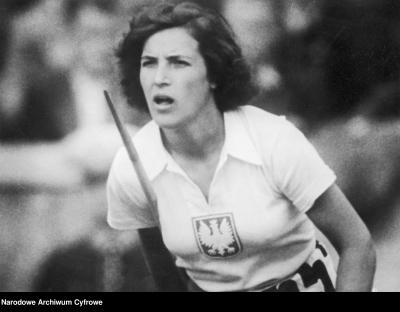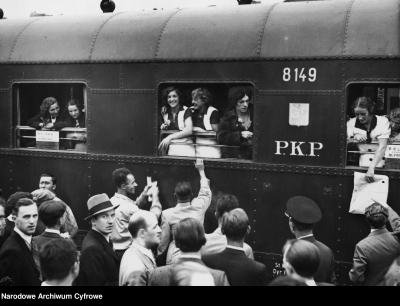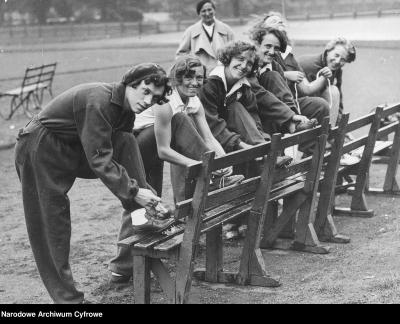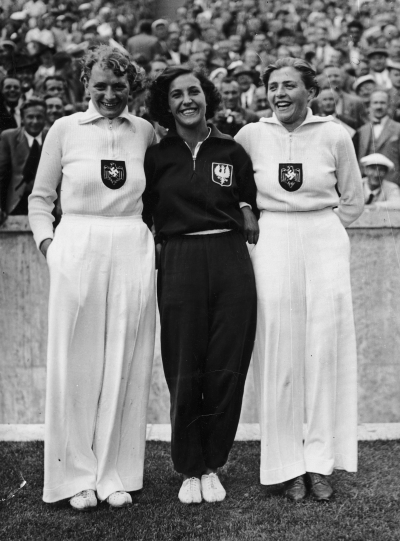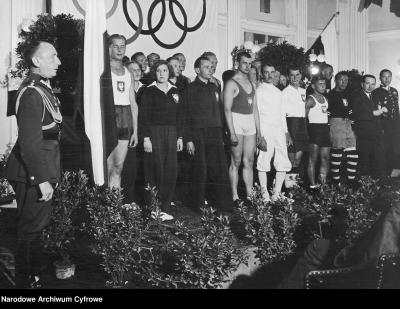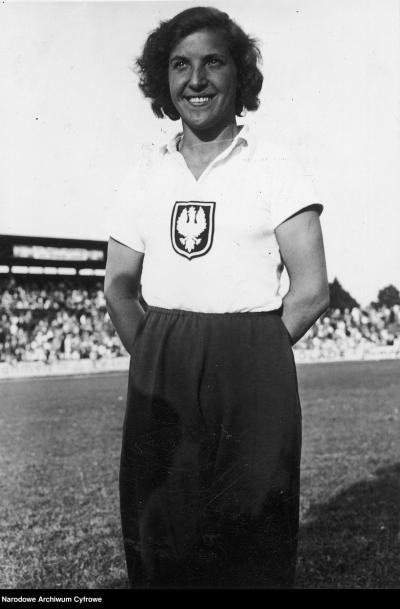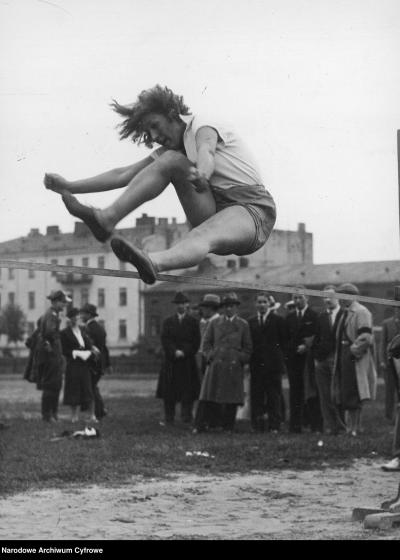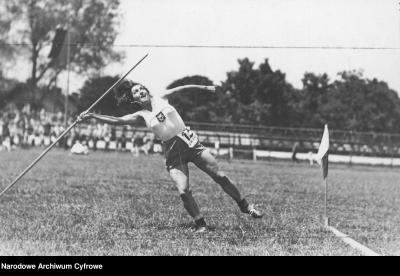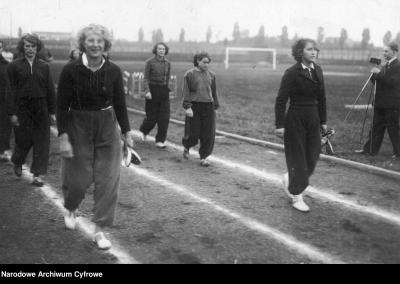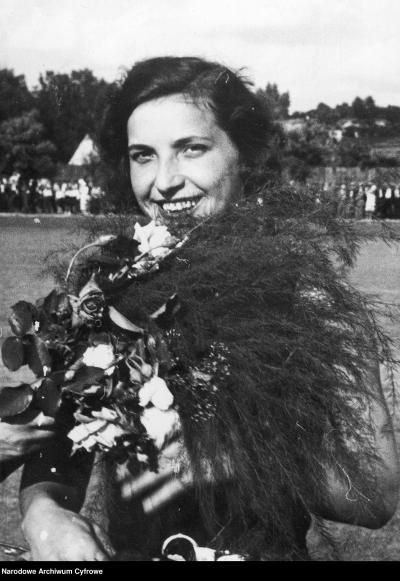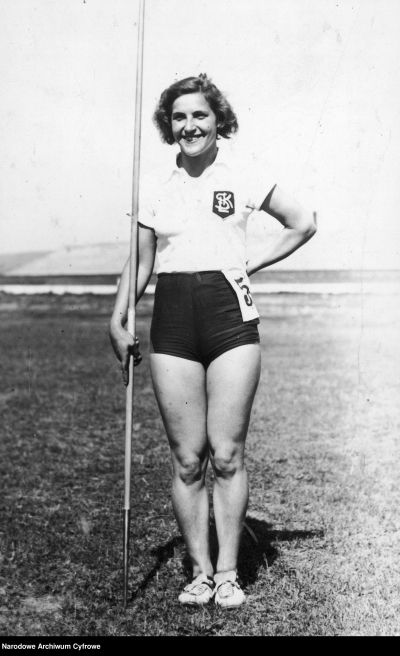Maria Kwaśniewska and the story of a photograph

Maria Kwaśniewska is born on 15 August 1913 in Łódź (Lodz), the daughter of Jan and Wiktoria Kozłowski. She has a peaceful childhood despite the fact, as she herself says, that her home life was very disciplined. Maria attends the girls’ grammar school which was named after Romana Sobolewska-Konopczyńska. It is here that she is discovered and mentored by her sports teacher Ludwik Szumlewski, who would later become a sports commentator for the local broadcasting service in Łódź and athletics trainer at Łódź Sports Club (Łódzki Klub Sportowy). Even at the first long jump training session, Maria Kwaśniewska astounds her trainer with her talent. When not quite 15 years old, the young sportswoman is awarded first prize for “promising sporting achievements” by the President of the Second Polish Republic, Ignacy Mościcki. Two years later, in 1930, she wins her first Polish championship in the long jump.
Her sporting career quickly gains momentum. The girl is a multi-talent, she really enjoys sport. She trains in everything that she can: Javelin, long jump, triathlon and pentathlon, volleyball and basketball and the team sport Hazena, the precursor to handball. However, her ultimate discipline is javelin, and for 15 years no one in Poland was able to beat her. In 1931, 1935, 1936, 1939 and 1946, Maria Kwaśniewska becomes a five-time national champion in this discipline. She wins a bronze medal in basketball at the third Women’s World Games in 1930 in Prague. An accolade that every athlete dreams of is an Olympic medal.
The Propaganda Games
The 1936 summer Olympics are hosted by Berlin. Three years earlier there was an outcry around the world when the International Olympic Committee (IOC) announced the venue. The brutality of the National Socialist regime is well known. Teams from many countries, including France, Great Britain, USA, and the Netherlands, consider boycotting the games. In the end, the games are held in Berlin despite the protests. This decision is partly influenced by the fact that the winter Olympics in Garmisch-Partenkirchen in February 1936 were held without a hitch. Apart from which, the National Socialists promise the IOC that they will allow athletes of Jewish heritage to participate in the games. Helene Mayer, a fencer with Jewish roots, is among the athletes. However, this promise turns out to be nothing more than lip service because in 1933 a ban was imposed on all other Jewish athletes preventing them from training and from participating in competitions. This effectively means that they had no chance of qualifying for the Olympic Games.
Whilst the games are on, all signs denying Jews access to certain places are removed from the Berlin cityscape and the National Socialists refrain from other anti-Jewish activities during this time. But this is all just for appearances: At the same time, 30 km north of Berlin the Nazis have begun to build the Sachsenhausen concentration camp. Sinti and Roma, who spoil the image of the Third Reich that the National Socialists want to show to the world, are rounded up in Marzahn on the outskirts of the city. The homeless and prostitutes all disappear from the streets of Berlin.
The little Pole
Poland sent 144 athletes, 127 men and 17 women to the Olympic Games in Berlin. Amongst them was the talented 23-year-old athlete Maria Kwaśniewska. On Sunday, 2 August 1936, the athletes go head to head in Berlin in adverse weather conditions. A strong wind is blowing and dark clouds gather over the Olympic Stadium. In the final of the Javelin, Maria Kwaśniewska steps up against two German athletes Othilie “Tilly” Fleischer and Luise Krüger in the battle for the medals. When it’s her turn she is completely focused, takes a couple of deep breaths, breathes on the tip of the javelin and throws.[1] Her javelin travels 41.80 metres. That wins Kwaśniewska third place and the bronze medal. Othilie Fleischer (45.18 m) wins, Luise Krüger (43.29 m) takes second place.
Adolf Hitler follows the contest between the athletes from his VIP box. After the medal ceremony, the Führerinvites the athletes to him so that he can congratulate them in person. The Propaganda Minister Joseph Goebbels and Hermann Göring, at that time the Minister for the Air Force of the Third Reich, are also in the box. It is on this occasion that Kwaśniewska famously insults Hitler. When Hitler says to her: “I congratulate the little Pole” she carelessly retorts: “I don't feel any smaller than you.”[2] To save the Führer from this embarrassing situation, the German press later reports that Hitler congratulated the “small Poland”, meaning the country and not the athlete. A memento of this event is a photograph of the three javelin throwers with Adolf Hitler, which will have a great impact only a few years later.
[1] In 1936, Leni Riefenstahl captured Maria Kwaśniewska’s participation at the Olympic Games in Berlin in her “Olympia – Fest der Völker” (Olympia - Festival of the Nations).
[2] The conversation with Maria Kwaśniewska-Maleszewska appeared under the heading “Ja bym za siebie nie wyszła” [I wouldn’t have got married] in the online edition of “Rzeczpospolita”, May 2000.
